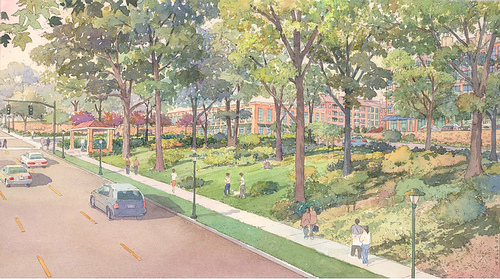Can a commercial enterprise succeed if hidden from view?
Yesterday, we discussed the plan for Prince George’s County first Whole Foods store. Besides the inappropriate strip mall design, it also contains a huge “buffer” between the development and Route 1, which could fatally damage the ability for this area to be successful.
Both the 2007 and 2008 versions of the project planned for a wooded buffer along Route 1 to separate the development from the single-family homes across the street in affluent University Park.
The current plan removes much of that wooded buffer, but not to create an active streetscape along the main street. Instead, it’s been shrunk from the interior edge to make room for more parking lots. If the latest sketches are accurate, there will be only a couple trees saved along Route 1.
It’s worth calling into question the provenance of such a buffer in the first place. One assumes it was to be set aside to preserve the wooded view for the 12 to 13 houses across from the property on the west side of Route 1. Those houses are already facing a four-lane arterial highway.
One would have to entertain a willing suspension of disbelief to think those houses are anywhere but on a busy road. Shielding the development from these dozen or so houses would make it nearly impossible for passing traffic to realize there is commercial space behind the trees, and the lack of visibility would almost certainly be a turn-off for business proprietors.
Right now, the proposed development site is zoned R-55 (residential-single-family). Before the Cafritz developers can build any portion of their proposed mixed-use development, they will need to obtain a zoning change from the Prince George’s County Planning Board of the Maryland-National Capital Planning Commission (M-NCPPC), and from the District Council (which is what the County Council calls itself when it sits as a zoning agency).
The M-NCPPC and the District Council approved a mixed-use town center plan for the Town of Riverdale Park in 2004. This plan covers the commercial areas of the town just south of the Cafritz Property. Thus, one rezoning option that the Cafritz developers would have is to apply to extend the Riverdale Park Mixed Use Town Center (M-U-TC) zone northward, to cover their property. This would allow them to build the Whole Foods along with the other commercial and multifamily residential components of their proposed development.
The Riverdale Park M-U-TC zoning regulations for that portion of Route 1 just south of the Cafritz property specifically prohibit parking between the street and the front of buildings. The intent of those regulations, according to the plan, is “[t]o retain and create a consistent street wall (abutting buildings aligned along a build-to line) that promotes a sense of enclosure (a street room), defines the sidewalk, and frames the street.”
Instead of designing its project to follow the streetscaping requirement of the plan, however, the development team uses creative language to explain its intent to sidestep those standards:
[W]e intend to deviate from the Riverdale Park MUTC Plan development district standards in one way. The current MUTC Plan encourages development to create a Route 1 street wall, with buildings tight to the Route 1 sidewalk. We intend to deviate from this pattern primarily because, in order to be compatible and respectful to the existing houses across the street, we are proposing a landscape buffer zone as our transition from Route 1 to our proposed multilevel retail/office buildings. In keeping with the spirit of the Riverdale Park MUTC Plan, our buildings will be tight to the internal sidewalk to create a comfortable and lively pedestrian experience, along our internal streets and not Route 1.
These “internal sidewalks” are simply pedestrian walkways alongside their parking lots. The “internal streets” are simply the driveways for the parking lots. By playing fast and loose with language, the proposed plan sounds like it’s adhering to good urban design principles, while it’s really a standard suburban big-box development.
The Riverdale Park MUTC Plan’s build-to line design standard is a “shall” command, which the Plan describes as “mandatory and not discretionary.” It says:
All new buildings shall be built within a specified distance (the build-to line) of the face-of-curb depending upon location, plus or minus the allowable variation.
In that area of Route 1, the mandatory build-to line is 10-15 feet from the curb, depending on the size of the sidewalk, with a permissible 4-foot variation. Therefore, if Cafritz wishes to obtain the M-U-TC zoning approval necessary to construct its project, the M-NCPPC and District Council should insist that Cafritz’s proposed development conform to the mandatory design standards of the Riverdale Park plan for Route 1.
The question is, will they? Unless somebody who becomes a party of record (like a neighborhood association or concerned citizen) raises the issue — both in writing, before the public hearing, and at the public hearing itself, it’s unlikely.
Even then, if history is any guide, the county will often strain to find a way to either ignore the standard or find a way to grant the developer a departure. But at least if the issue is raised, the M-NCPPC and the District Council will have to address it. The good news is anyone can become a party of record by filling out this form and/or by appearing at the hearing and testifying.



